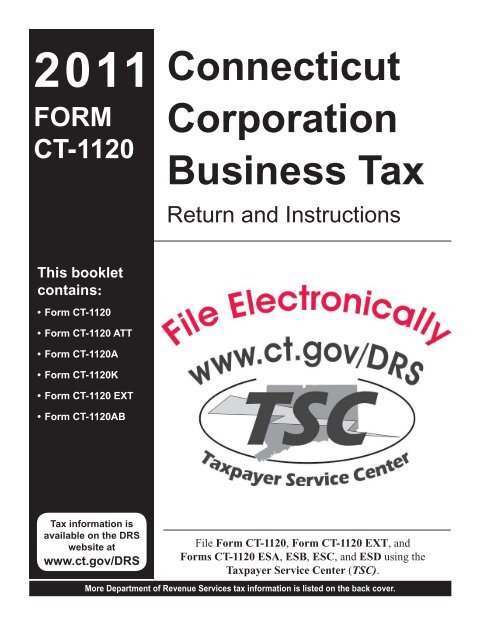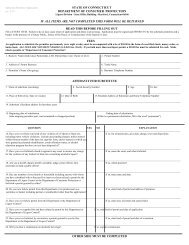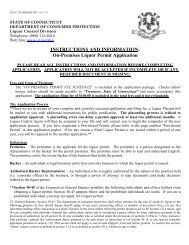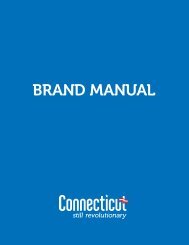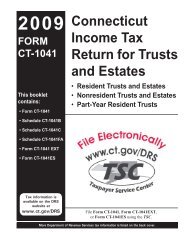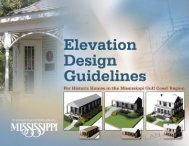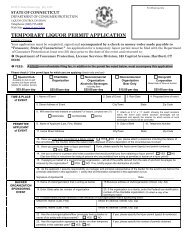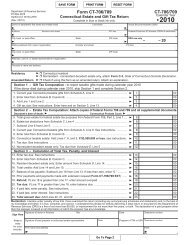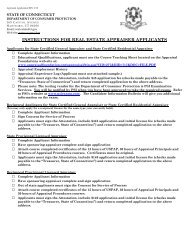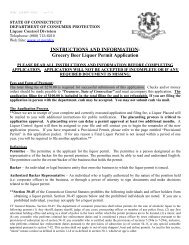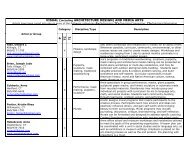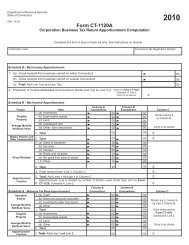CT-1120 Instructions, 2011 Connecticut corporation Business Tax ...
CT-1120 Instructions, 2011 Connecticut corporation Business Tax ...
CT-1120 Instructions, 2011 Connecticut corporation Business Tax ...
Create successful ePaper yourself
Turn your PDF publications into a flip-book with our unique Google optimized e-Paper software.
<strong>2011</strong><br />
FORM<br />
<strong>CT</strong>-<strong>1120</strong><br />
<strong>Connecticut</strong><br />
Corporation<br />
<strong>Business</strong> <strong>Tax</strong><br />
Return and <strong>Instructions</strong><br />
This booklet<br />
contains:<br />
• Form <strong>CT</strong>-<strong>1120</strong><br />
• Form <strong>CT</strong>-<strong>1120</strong> ATT<br />
• Form <strong>CT</strong>-<strong>1120</strong>A<br />
• Form <strong>CT</strong>-<strong>1120</strong>K<br />
• Form <strong>CT</strong>-<strong>1120</strong> EXT<br />
• Form <strong>CT</strong>-<strong>1120</strong>AB<br />
<strong>Tax</strong> information is<br />
available on the DRS<br />
website at<br />
www.ct.gov/DRS<br />
File Form <strong>CT</strong>-<strong>1120</strong>, Form <strong>CT</strong>-<strong>1120</strong> EXT, and<br />
Forms <strong>CT</strong>-<strong>1120</strong> ESA, ESB, ESC, and ESD using the<br />
<strong>Tax</strong>payer Service Center (TSC).<br />
More Department of Revenue Services tax information is listed on the back cover.
What This Booklet Contains<br />
Read the information contained in this booklet carefully<br />
before preparing the <strong>Connecticut</strong> <strong>corporation</strong> business<br />
tax return.<br />
This booklet contains information and instructions about<br />
the following forms:<br />
Form <strong>CT</strong>-<strong>1120</strong>, Corporation <strong>Business</strong> <strong>Tax</strong> Return, is<br />
used to compute tax both on a net income basis and on<br />
a capital stock basis. <strong>Tax</strong> is paid on the basis that yields<br />
the higher tax. The minimum tax is $250.<br />
Form <strong>CT</strong>-<strong>1120</strong> ATT, Corporation <strong>Business</strong> <strong>Tax</strong><br />
Return Attachment, contains the following computation<br />
schedules:<br />
Schedule H, <strong>Connecticut</strong> Apportioned Operating<br />
Loss Carryover;<br />
Schedule I, Dividend Deduction; and<br />
Schedule J, Bonus Depreciation Recovery.<br />
Form <strong>CT</strong>-<strong>1120</strong>A, Corporation <strong>Business</strong> <strong>Tax</strong> Return<br />
Apportionment Computation, is used to compute the<br />
apportionment factors for the net income and the<br />
minimum tax base.<br />
Form <strong>CT</strong>-<strong>1120</strong>K, <strong>Business</strong> <strong>Tax</strong> Credit Summary, is used<br />
to summarize a <strong>corporation</strong>’s claim for available business<br />
tax credits.<br />
Form <strong>CT</strong>-<strong>1120</strong> EXT, Application for Extension of Time<br />
to File Corporation <strong>Business</strong> <strong>Tax</strong> Return, is submitted<br />
to obtain an extension of time to file Form <strong>CT</strong>-<strong>1120</strong>;<br />
Form <strong>CT</strong>-<strong>1120</strong>CR, Combined Corporation <strong>Business</strong><br />
<strong>Tax</strong> Return; or Form <strong>CT</strong>-<strong>1120</strong>U, Unitary Corporation<br />
<strong>Business</strong> <strong>Tax</strong> Return.<br />
Form <strong>CT</strong>-<strong>1120</strong>AB, Summary of Add Back and Exceptions<br />
to Add Back of Interest and Intangible Expenses, is used<br />
to add back otherwise deductible interest expenses and<br />
costs and intangible expenses and costs paid to a related<br />
member, and must be completed by each <strong>corporation</strong> that<br />
pays interest or intangible expenses to a related party.<br />
Visit the Department of Revenue Services (DRS) website<br />
at www.ct.gov/DRS to download and print <strong>Connecticut</strong><br />
tax forms and publications.<br />
Other <strong>Tax</strong>es for Which the Corporation May<br />
be Liable<br />
The information that follows is intended to be a general<br />
description of other <strong>Connecticut</strong> taxes for which a<br />
<strong>corporation</strong> may be liable. Failure to pay these or any<br />
taxes for which the <strong>corporation</strong> is liable may subject<br />
the <strong>corporation</strong> and its officers to civil and criminal<br />
penalties.<br />
To register for sales and use taxes, <strong>Connecticut</strong> income<br />
tax withholding, and most other <strong>Connecticut</strong> taxes<br />
administered by DRS, the <strong>corporation</strong> must complete<br />
Form REG-1, <strong>Business</strong> <strong>Tax</strong>es Registration Application.<br />
Visit the DRS website to register online. If the <strong>corporation</strong><br />
already has a <strong>Connecticut</strong> <strong>Tax</strong> Registration Number,<br />
additional taxes for which the <strong>corporation</strong> is liable may<br />
be added to the registration by contacting the DRS<br />
Registration Unit at 860-297-4885.<br />
<strong>Business</strong> Entity <strong>Tax</strong>: The business entity tax (BET) is<br />
an annual tax of $250 imposed on the following business<br />
types:<br />
• S <strong>corporation</strong>s (Qualified subchapter S subsidiaries<br />
(QSSS) are not liable for the BET.);<br />
• Limited liability companies (LLCs or SMLLCs) that<br />
are, for federal income tax purposes, either:<br />
• Treated as a partnership, if it has two or more<br />
members; or<br />
• Disregarded as an entity separate from its owner,<br />
if it has a single member;<br />
• Limited liability partnerships (LLPs); and<br />
• Limited partnership (LPs).<br />
The BET applies to those business entities listed above<br />
if either: 1) the entities were formed under <strong>Connecticut</strong><br />
law; or 2) the entities were not formed under <strong>Connecticut</strong><br />
law but are required to register with or obtain a certificate<br />
of authority from the <strong>Connecticut</strong> Secretary of the State<br />
before transacting business in the state (regardless of<br />
whether or not the entities have complied with the<br />
requirement). Visit the DRS website at www.ct.gov/bet<br />
for additional information regarding the BET.<br />
<strong>Connecticut</strong> Sales and Use <strong>Tax</strong>es: A <strong>corporation</strong><br />
may be responsible for the filing of sales and use tax<br />
returns. Sales taxes are due if the company sells taxable<br />
goods or services. Use taxes are due on the purchase of<br />
taxable goods or services from out-of-state retailers or<br />
<strong>Connecticut</strong> retailers who have failed to collect the sales<br />
tax. Both taxes are reported on Form OS-114, Sales and<br />
Use <strong>Tax</strong> Return.<br />
<strong>Connecticut</strong> Income <strong>Tax</strong> Withholding: Any <strong>corporation</strong><br />
that maintains an office or transacts business in<br />
<strong>Connecticut</strong> and that is considered an employer for<br />
federal income tax withholding purposes must withhold<br />
<strong>Connecticut</strong> income tax from wages and certain other<br />
payments to employees, whether or not the payroll<br />
department is located in <strong>Connecticut</strong>.<br />
Controlling Interest Transfer <strong>Tax</strong>: <strong>Connecticut</strong> imposes<br />
a tax on the transfer of a controlling interest in an entity<br />
where the entity owns, directly or indirectly, an interest in<br />
<strong>Connecticut</strong> real property. This tax is reported on Form<br />
AU-330, Controlling Interest Transfer <strong>Tax</strong>es.<br />
Page 2
Table of Contents<br />
What’s New ............................................. 4<br />
General Information ............................... 7<br />
How to Get Help ..........................................7<br />
Forms and Publications ...............................7<br />
Who Must File .............................................7<br />
Who is Exempt From Corporation<br />
<strong>Business</strong> <strong>Tax</strong> ...............................................7<br />
Accounting Period and Method of<br />
Accounting ..................................................7<br />
When to File ...............................................7<br />
Extension Request ......................................8<br />
Where to File ..............................................8<br />
File Electronically . . . 8<br />
File a Paper Return . . . 8<br />
Payment Options .........................................8<br />
Pay Electronically . . . 8<br />
Pay by Credit Card or Debit Card . . .8<br />
Pay by Mail . . .8<br />
Amended Returns ........................................9<br />
Estimated <strong>Tax</strong> Payments .............................9<br />
Interest and Penalties ..................................9<br />
Penalty for Late<br />
Payment or Late Filing . . . 9<br />
Penalty for Willful<br />
Failure to File or Pay . . . 10<br />
Penalty for Willful Filing<br />
of a Fraudulent or<br />
Materially False Return . . . 10<br />
Penalty for Failure to<br />
Listed Transaction . . . 10<br />
Waiver of Penalty .......................................10<br />
Status Letter Requests ..............................10<br />
Recordkeeping ..........................................10<br />
Copies of Returns ......................................10<br />
Form <strong>CT</strong>-<strong>1120</strong> General <strong>Instructions</strong> .....11<br />
Required Information .................................11<br />
NAICS Code for Principal <strong>Business</strong><br />
Activity .......................................................11<br />
Check and Complete all Applicable Boxes 11<br />
1. Change of Address . . . 11<br />
2. Return Status . . . 11<br />
3. Final Return . . .11<br />
4. Type of Federal Return Filed . . . 12<br />
5. Exchange of Research<br />
and Development <strong>Tax</strong> Credit . . . 12<br />
6. Previous Combined<br />
or Unitary Return . . . 12<br />
7. Combined or Unitary Return. . . 12<br />
8. Principal Place of <strong>Business</strong> . . . 12<br />
9. Exempt Corporation . . . 12<br />
10. Annualization . . . 12<br />
11. Interest Add Back . . . 12<br />
12. Passive Investment Companies . . . 12<br />
13. Average Monthly Net<br />
Employment Gain . . . 12<br />
Form <strong>CT</strong>-<strong>1120</strong> Line <strong>Instructions</strong> .......... 13<br />
Rounding Off to Whole Dollars ..................13<br />
Schedule A - Computation of <strong>Tax</strong><br />
on Net Income ...........................................13<br />
Schedule B - Computation of<br />
Minimum <strong>Tax</strong> on Capital ............................13<br />
Schedule C - Computation of<br />
Amount Payable ........................................14<br />
Schedule D - Computation of<br />
Net Income ................................................15<br />
Schedule E - Computation of<br />
Minimum <strong>Tax</strong> Base ....................................15<br />
Schedule F - <strong>Tax</strong>es ....................................16<br />
Schedule G - Additional Required<br />
Information .................................................16<br />
Signature ...................................................16<br />
Paid Preparer Signature ............................16<br />
Paid Preparer Authorization .......................16<br />
<strong>Connecticut</strong> <strong>Tax</strong><br />
Assistance ............................. Back Cover<br />
Page 3
What’s New<br />
Direct Deposit Refund Option<br />
Beginning in the <strong>2011</strong> income year, a taxpayer may<br />
elect to have its refund amount directly deposited into<br />
a checking or savings account.<br />
Estimated <strong>Tax</strong>es<br />
Beginning with estimated tax payments for the 2012<br />
income year, a taxpayer that has filed its return on or<br />
before its due date or extended due date may apply an<br />
overpayment reported on such return against the first<br />
installment of estimated tax due for the succeeding<br />
income year.<br />
Conn. Gen. Stat. §12-242g, as amended by <strong>2011</strong><br />
Conn. Pub. Acts 61, §56.<br />
<strong>Tax</strong> Credit Limitation<br />
A taxpayer may use tax credits to offset more than<br />
70% of its tax due for income year <strong>2011</strong> and income<br />
year 2012 if the taxpayer has an average monthly<br />
net employment gain of greater than zero. Only<br />
employees who work at least 35 hours a week and<br />
who were not employed by a related person are taken<br />
into account in making this computation. The amount<br />
by which the taxpayer may exceed the 70% limitation<br />
is calculated on Form <strong>CT</strong>-<strong>1120</strong> TCE, <strong>Tax</strong> Credit Cap<br />
Expansion.<br />
Conn. Gen. Stat. §12-217zz, as amended by <strong>2011</strong><br />
Conn. Pub. Acts 6, §78.<br />
Foreign Corporations<br />
A foreign <strong>corporation</strong> that does not have U.S.<br />
effectively connected income (ECI) is exempted from<br />
the economic nexus provision. A foreign <strong>corporation</strong><br />
that has ECI shall have gross income for <strong>Connecticut</strong><br />
purposes equal to such ECI. Only property, payroll,<br />
and receipts that are effectively connected with a<br />
foreign <strong>corporation</strong>’s U.S. trade or business shall<br />
be used in calculating the foreign <strong>corporation</strong>’s<br />
<strong>Connecticut</strong> apportionment fraction.<br />
Conn. Gen. Stat. §12-216a, as amended by <strong>2011</strong><br />
Conn. Pub. Acts 61, §55.<br />
Job Expansion <strong>Tax</strong> Credit<br />
A new tax credit program has been established for<br />
taxpayers that hire new employees to fill new jobs<br />
after January 1, 2012 and before January 1, 2014.<br />
Page 4<br />
The amount of the tax credit is $500 per month for<br />
a new employee and $900 per month for a veteran<br />
employee or a qualifying employee. A new employee<br />
is a person who resides in <strong>Connecticut</strong> and is hired by a<br />
taxpayer to fill a new job. A veteran employee is a new<br />
employee who, at the time of hiring by the taxpayer,<br />
is a member of, was honorably discharge from or<br />
released under honorable conditions from active<br />
service in the armed forces. A qualifying employee<br />
is a new employee who, at the time of hiring by the<br />
taxpayer, is receiving unemployment compensation,<br />
has exhausted unemployment compensation without an<br />
intervening job, or is receiving vocational rehabilitative<br />
services from the Bureau of Rehabilitative Services.<br />
The employees must be hired to work full-time jobs<br />
or, for employees receiving vocational rehabilitative<br />
services, to work at least 20 hours per week for at least<br />
48 weeks per year.<br />
A business must apply to the Department of Economic<br />
and Community Development (DECD) for this tax<br />
credit and cannot claim any other tax credit with<br />
respect to the same employees. A taxpayer can claim<br />
this tax credit in the income year the credit is earned<br />
and the next two income years, but the tax credit<br />
cannot exceed the amount of tax due and does not<br />
carryforward. The tax credit can be claimed against<br />
the taxes imposed under Conn. Gen. Stat. chapters<br />
207, 208, 212, or 229 (other than Conn. Gen. Stat.<br />
§12-707).<br />
If a taxpayer has previously been issued an eligibility<br />
letter or certificate under the New Jobs Creation tax<br />
credit, the Qualified Small <strong>Business</strong> Job Creation tax<br />
credit, or the Vocational Rehabilitation Job Creation<br />
tax credit, then the provisions of those tax credits shall<br />
apply to the taxpayer for the duration of the eligibility<br />
letter or certificate.<br />
<strong>2011</strong> Conn. Pub. Acts 1 (Oct. Spec. Sess.), §19.<br />
Manufacturing Reinvestment Account<br />
Program<br />
A manufacturing reinvestment account (MRA)<br />
program has been established to allow manufacturers<br />
to set aside money to pay for certain qualifying<br />
expenses. For income years commencing on or<br />
after January 1, 2012, a manufacturer subject to the<br />
<strong>corporation</strong> business tax shall deduct from gross<br />
income any contribution to an MRA for the income<br />
year in which the contribution is made.
An MRA is a trust created or organized by a<br />
manufacturer that has no more than 50 employees<br />
and is held by a <strong>Connecticut</strong> bank for the benefit of<br />
the manufacturer. DECD will establish criteria and<br />
guidelines to select not more than 100 manufacturers<br />
that may establish MRAs. Once selected, a<br />
manufacturer can contribute the lesser of the following<br />
to an MRA per income year:<br />
1. $100,000 for income years commencing on or<br />
after January 1, 2012 and $50,000 for income<br />
years commencing on or after January 1, <strong>2011</strong><br />
and prior to January 1, 2012; or<br />
2. The manufacturer’s domestic gross receipts.<br />
Disbursements from an MRA may be used to<br />
purchase machinery, equipment, manufacturing<br />
facilities or for workforce training, development or<br />
expansion. Disbursements from an MRA are subject<br />
to a tax of 3.5%. Any money, along with any interest,<br />
remaining in an MRA after 5 years is returned to<br />
the manufacturer and is subject to a tax of the full<br />
rate under chapter 208 of the <strong>Connecticut</strong> General<br />
Statutes. Such tax must be paid within 60 days of the<br />
money being returned to the manufacturer.<br />
<strong>2011</strong> Conn. Pub. Acts 140, §4 as amended by <strong>2011</strong><br />
Conn. Pub. Acts 1 (Oct. Spec. Sess.), §18; Conn. Gen.<br />
Stat. §12-217, as amended by <strong>2011</strong> Conn. Pub. Acts<br />
140, §5.<br />
Changes to Existing <strong>Tax</strong> Credits<br />
Film Production <strong>Tax</strong> Credit: The percentage<br />
of principal photography days that an eligible<br />
production company must conduct in <strong>Connecticut</strong><br />
is increased from 25% to 50%. The amount of tax<br />
credit that a production company that is not subject<br />
to tax under chapters 207 or 208 of the <strong>Connecticut</strong><br />
General Statutes may assign is restricted to not more<br />
than 50% in the <strong>2011</strong> income year and not more than<br />
25% in income years after <strong>2011</strong>. The 50% and 25%<br />
restrictions do not apply if the qualified production is<br />
filmed at a qualified production facility that:<br />
1. Is located in <strong>Connecticut</strong>;<br />
2. Is intended for film, television, or digital media<br />
production; and<br />
3. Has an investment of $3 million, or less if the<br />
Commissioner of Economic and Community<br />
Development determines such facility otherwise<br />
qualifies.<br />
The 50% and 25% restrictions also do not apply to an<br />
entity that owns 50% or more, directly or indirectly, of<br />
an entity that is subject to the business entity tax under<br />
chapter 213a of the <strong>Connecticut</strong> General Statutes.<br />
Additionally, the definition of a qualified production<br />
now includes a relocated television production.<br />
A relocated television production is an ongoing<br />
television program that may include current events<br />
(other than general news, sporting events or game<br />
broadcasts) where all prior seasons were filmed outside<br />
this state, where the production is created at a qualified<br />
production facility that has a minimum investment of<br />
$25 million by the eligible production company on<br />
or after January 1, 2012 and where 200 new jobs are<br />
created in <strong>Connecticut</strong> on or after January 1, 2012. A<br />
relocated television production may be certified for this<br />
tax credit for no more than 10 successive income years.<br />
Conn. Gen. Stat. §12-217jj, as amended by <strong>2011</strong> Conn.<br />
Pub. Acts 6, §77, <strong>2011</strong> Conn. Pub. Acts 61, §37 and<br />
<strong>2011</strong> Conn. Pub. Act 1 (Oct. Spec. Sess.), §53.<br />
Neighborhood Assistance Act <strong>Tax</strong> Credit: The<br />
definition of business firm now includes entities<br />
subject to the business entity tax under chapter 213a<br />
of the <strong>Connecticut</strong> General Statutes. Although a<br />
business firm subject to tax under chapter 213a of<br />
the <strong>Connecticut</strong> General Statutes can earn the tax<br />
credit, the credit can only be applied against the<br />
taxes imposed under chapters 207, 208, 209, 210,<br />
211, or 212 of the <strong>Connecticut</strong> General Statutes. The<br />
tax credit earned by a business entity subject to the<br />
provisions of chapter 213a of the <strong>Connecticut</strong> General<br />
Statutes may be used by the members or partners of<br />
such entity that are subject to tax under chapter 208 of<br />
the <strong>Connecticut</strong> General Statutes. The amount of tax<br />
credit allowed annually per business firm is increased<br />
from $75,000 to $150,000. A business firm no longer<br />
needs to meet or exceed its overall contributions to<br />
charity from the preceding year in order to be granted<br />
this tax credit.<br />
Conn. Gen. Stat. §12-631, as amended by <strong>2011</strong> Conn.<br />
Pub. Acts 140, §27; Conn. Gen. Stat. §12-632, as<br />
amended by <strong>2011</strong> Conn. Pub. Acts 140, §28.<br />
Film Production Infrastructure <strong>Tax</strong> Credit: A<br />
taxpayer can now claim this tax credit in the income<br />
year the credit is earned and the next three income<br />
years, but the tax credit may no longer be carried<br />
forward after it is claimed.<br />
Conn. Gen. Stat. §12-217kk as amended by <strong>2011</strong><br />
Conn. Pub. Acts 1 (Oct. Spec. Sess.), §55.<br />
Page 5
Phase out of the New Jobs Creation <strong>Tax</strong> Credit: As<br />
of January 1, 2012, the Commissioner of Economic<br />
and Community Development may no longer issue<br />
eligibility certificates for the New Jobs Creation tax<br />
credit. Additionally, no tax credit shall be granted<br />
more than five years after the date the Commissioner<br />
of Economic and Community Development issues<br />
and eligibility certificate.<br />
Conn. Gen. Stat. §12-217ii, as amended by <strong>2011</strong><br />
Conn. Pub. Acts 6, §130, <strong>2011</strong> Conn. Pub. Acts 86, §3<br />
and <strong>2011</strong> Conn. Pub. Acts 1 (Oct. Spec. Sess.), §20.<br />
Phase out of the Vocational Rehabilitation Jobs<br />
Creation <strong>Tax</strong> Credit: The definition of new qualifying<br />
employee has been changed to employees hired by the<br />
employer to fill a new job after May 6, 2010, during<br />
the employer’s income years commencing on or after<br />
January 1, 2010, and prior to January 1, 2012.<br />
Conn. Gen. Stat. §12-217oo, as amended by <strong>2011</strong><br />
Conn. Pub. Acts 6, §132 and Conn. Pub. Acts 1 (Oct.<br />
Spec. Sess.), §22.<br />
Page 6
General Information<br />
How to Get Help<br />
DRS is ready to help you get answers to <strong>Connecticut</strong> tax<br />
questions. Visit the DRS website at www.ct.gov/DRS or<br />
call 800-382-9463 (<strong>Connecticut</strong> calls outside the Greater<br />
Hartford calling area only) or 860-297-5962 (from<br />
anywhere) during business hours. For personal assistance<br />
visit the DRS office at 25 Sigourney Street, Hartford. Be<br />
sure to bring your completed federal return if applicable.<br />
Forms and Publications<br />
Visit the DRS website at www.ct.gov/DRS to download<br />
and print <strong>Connecticut</strong> tax forms and publications anytime.<br />
Who Must File<br />
Form <strong>CT</strong>-<strong>1120</strong>, Corporation <strong>Business</strong> <strong>Tax</strong> Return, must<br />
be filed by every <strong>corporation</strong> (or association taxable as a<br />
<strong>corporation</strong>) that carries on business or has the right to carry<br />
on business in <strong>Connecticut</strong>. Any <strong>corporation</strong> dissolved or<br />
withdrawn from <strong>Connecticut</strong> is subject to the <strong>corporation</strong><br />
business tax up to the date of dissolution or withdrawal.<br />
Corporations electing to file a combined return must also<br />
complete Form <strong>CT</strong>-<strong>1120</strong>CR, Combined Corporation<br />
<strong>Business</strong> <strong>Tax</strong> Return.<br />
Corporations electing to file a unitary return must<br />
also complete Form <strong>CT</strong>-<strong>1120</strong>U, Unitary Corporation<br />
<strong>Business</strong> <strong>Tax</strong> Return.<br />
Who is Exempt From Corporation<br />
<strong>Business</strong> <strong>Tax</strong><br />
The following companies are exempt from filing<br />
Form <strong>CT</strong>-<strong>1120</strong>:<br />
• Insurance companies incorporated under the laws of<br />
any other state or foreign government, and domestic<br />
insurance companies;<br />
• Companies exempt by the federal <strong>corporation</strong> net<br />
income tax law;<br />
• A domestic international sales <strong>corporation</strong> (DISC)<br />
which has made a valid election for federal income<br />
tax purposes to be treated as a DISC;<br />
• Companies subject to gross earnings taxes under<br />
Chapter 210 of the <strong>Connecticut</strong> General Statutes<br />
or whose properties in <strong>Connecticut</strong> are operated by<br />
railroad companies subject to gross earnings taxes<br />
under Chapter 210;<br />
• Cooperative housing <strong>corporation</strong>s, as defined for<br />
federal income tax purposes;<br />
• Corporate limited partners in one or more investment<br />
partnerships that are otherwise not doing business in<br />
<strong>Connecticut</strong>; and<br />
• Non-United States <strong>corporation</strong>s whose sole activity<br />
in <strong>Connecticut</strong> is trading in stocks, securities, or<br />
commodities for their own account.<br />
The following companies, organizations, or associations<br />
are exempt from payment of <strong>Connecticut</strong> <strong>corporation</strong><br />
business tax but must register with DRS and file Form<br />
<strong>CT</strong>-<strong>1120</strong> to claim the exemption:<br />
• A homeowner’s association that has elected to be<br />
treated as such for federal income tax purposes<br />
(a copy of federal Form <strong>1120</strong>-H must be attached to<br />
its Form <strong>CT</strong>-<strong>1120</strong>);<br />
• Certain political organizations or associations exempt<br />
from federal income taxes under IRC §527 (if the<br />
organization or association files federal Form <strong>1120</strong>-POL,<br />
then it must be attached to the Form <strong>CT</strong>-<strong>1120</strong>);<br />
• Financial service companies whose corporate<br />
headquarters are located in the export zone in the City<br />
of Hartford, <strong>Connecticut</strong>, and who are conducting all<br />
of their business outside the United States; and<br />
• Passive investment companies (PICs), as defined<br />
under Conn. Gen. Stat. §12-213(a)(27), must file<br />
Form <strong>CT</strong>-<strong>1120</strong> PIC, Information Return for Passive<br />
Investment Companies, in place of Form <strong>CT</strong>-<strong>1120</strong>.<br />
Accounting Period and Method of<br />
Accounting<br />
A <strong>corporation</strong> must use the same accounting period<br />
and method of accounting for <strong>Connecticut</strong> tax purposes<br />
as it does for federal tax purposes. If a <strong>corporation</strong>’s<br />
accounting period or method of accounting is changed<br />
for federal tax purposes, the same change must be made<br />
for <strong>Connecticut</strong> tax purposes.<br />
When to File<br />
Every <strong>corporation</strong> must file a return on or before the first<br />
day of the month following the due date of the company’s<br />
corresponding federal income tax return for the income<br />
year (April 1 for calendar year taxpayers). In the case<br />
of any company that is not required to file a federal<br />
income tax return for the income year, the <strong>Connecticut</strong><br />
<strong>corporation</strong> business tax return is due on or before the first<br />
day of the fourth month following the end of the income<br />
year. If the due date falls on a Saturday, Sunday, or legal<br />
holiday, the next business day is the due date.<br />
The return will meet the timely filed and timely payment<br />
rules if the U.S. Postal Service cancellation date, or the<br />
date recorded or marked by a designated private delivery<br />
service (PDS) using a designated type of service, is on or<br />
before the due date. Not all services provided by these<br />
designated PDSs qualify.<br />
Page 7
The following are the designated PDSs and designated<br />
types of service at the time of publication:<br />
Federal Express (FedEx)<br />
• FedEx Priority Overnight<br />
• FedEx Standard Overnight<br />
• FedEx 2Day<br />
• FedEx International Priority<br />
• FedEx International First<br />
United Parcel Service (UPS)<br />
• UPS Next Day Air<br />
• UPS Next Day Air Saver<br />
• UPS 2nd Day Air<br />
• UPS 2nd Day Air A.M.<br />
• UPS Worldwide Express Plus<br />
• UPS Worldwide Express<br />
This list is subject to change. See Policy Statement<br />
2008(3), Designated Private Delivery Services and<br />
Designated Types of Service.<br />
If Form <strong>CT</strong>-<strong>1120</strong> is filed late, see Interest and Penalties<br />
to determine if interest and penalty should be reported<br />
with this return.<br />
Extension Request<br />
To get an extension of time to file the annual return, the<br />
<strong>corporation</strong> must file Form <strong>CT</strong>-<strong>1120</strong> EXT, Application<br />
for Extension of Time to File Corporation <strong>Business</strong> <strong>Tax</strong><br />
Return, not later than the first day of the month following<br />
the due date of the company’s corresponding federal<br />
income tax return for the income year (April 1 for calendar<br />
year taxpayers). In the case of any company not required<br />
to file a federal income tax return for the income year,<br />
the extension request must be filed on or before the first<br />
day of the fourth month following the end of the income<br />
year. Payment of the total tax due must be included with<br />
the request. The timely filing of Form <strong>CT</strong>-<strong>1120</strong> EXT will<br />
automatically extend the due date for six months.<br />
Visit www.ct.gov/TSC to file your extension request<br />
over the Internet.<br />
Form <strong>CT</strong>-<strong>1120</strong> EXT extends only the time to file the tax<br />
return. It does not extend the time to pay the <strong>corporation</strong><br />
business tax. Interest on any tax not paid by the original<br />
due date is computed at 1% per month or fraction of a<br />
month until the tax is paid in full.<br />
Where to File<br />
File Electronically<br />
This return can be filed electronically through the DRS<br />
<strong>Tax</strong>payer Service Center (TSC). The TSC allows<br />
taxpayers to electronically file, pay, and manage state<br />
tax responsibilities. Visit www.ct.gov/TSC to make<br />
electronic transactions or administer your tax account<br />
online. If you file electronically you are expected to pay<br />
electronically at the time of filing.<br />
File a Paper Return<br />
Mail paper return with payment to:<br />
Department of Revenue Services<br />
State of <strong>Connecticut</strong><br />
PO Box 2974<br />
Hartford <strong>CT</strong> 06104-2974<br />
Mail paper return without payment to:<br />
Department of Revenue Services<br />
State of <strong>Connecticut</strong><br />
PO Box 150406<br />
Hartford <strong>CT</strong> 06115-0406<br />
Payment Options<br />
Pay Electronically<br />
Visit www.ct.gov/TSC to use the TSC<br />
to make a direct tax payment. After logging into the<br />
TSC, select the Make Payment Only option and choose<br />
a tax type from the drop down box. Using this option<br />
authorizes DRS to electronically withdraw a payment<br />
from your bank account (checking or savings) on a date<br />
you select up to the due date. As a reminder, even if you<br />
pay electronically you must still file your return on or<br />
before the due date. <strong>Tax</strong> not paid on or before the due<br />
date will be subject to penalty and interest.<br />
Pay by Credit Card or Debit Card<br />
You may elect to pay your tax liability using a credit<br />
card (American Express®, Discover®, MasterCard®,<br />
or VISA®) or comparable debit card. A convenience<br />
fee will be charged by the service provider. You will be<br />
informed of the amount of the fee and you may elect to<br />
cancel the transaction. At the end of the transaction you<br />
will be given a confirmation number for your records.<br />
There are three ways to pay by credit card or comparable<br />
debit card:<br />
• Log in to your account in the TSC and select Make<br />
Payment by Credit Card;<br />
• Visit: www.officialpayments.com and select State<br />
Payments; or<br />
• Call Official Payments Corporation toll-free at<br />
1-800-2PAY-TAX (1-800-272-9829) and follow<br />
the instructions. You will be asked to enter the<br />
<strong>Connecticut</strong> Jurisdiction Code: 1777.<br />
Your payment will be effective on the date you make<br />
the charge.<br />
Pay by Mail<br />
Make check payable to Commissioner of Revenue<br />
Services. To ensure payment is applied to the correct<br />
account, write “<strong>2011</strong> Form <strong>CT</strong>-<strong>1120</strong>” and the <strong>corporation</strong>’s<br />
<strong>Connecticut</strong> <strong>Tax</strong> Registration Number on the front of the<br />
check. Be sure to sign your check and paper clip it to the<br />
front of your return. Do not send cash. DRS may submit<br />
your check to your bank electronically.<br />
Page 8
Amended Returns<br />
For income years beginning on or after January 1, 2006,<br />
any <strong>corporation</strong> that fails to include items of income or<br />
deduction or makes any other error on a return must:<br />
1. File an amended return using Form <strong>CT</strong>-<strong>1120</strong>X,<br />
Amended Corporation <strong>Business</strong> <strong>Tax</strong> Return, that<br />
applies to the tax year being amended; or<br />
2. If the <strong>corporation</strong> was included in a combined<br />
<strong>corporation</strong> business tax return, file an amended<br />
combined return on Form <strong>CT</strong>-<strong>1120</strong>CR, Combined<br />
Corporation <strong>Business</strong> <strong>Tax</strong> Return, that applies to the<br />
tax year being amended and check the Amended box.<br />
If a <strong>corporation</strong> has filed an amended federal return with<br />
the IRS and the amendment affects the <strong>corporation</strong>’s<br />
<strong>Connecticut</strong> tax return, then within 90 days of the IRS<br />
final determination on that amended federal return, the<br />
<strong>corporation</strong> shall file Form <strong>CT</strong>-<strong>1120</strong>X, and attach a copy<br />
of federal Form <strong>1120</strong>X, Amended U.S. Corporation<br />
Income <strong>Tax</strong> return.<br />
Corrections to taxable income made by the IRS must be<br />
reported to the Commissioner of Revenue Services on or<br />
before 90 days after the final determination of the change.<br />
All federal adjustments must be reported on an amended<br />
return. An extension request for reporting federal audit<br />
changes may be submitted in writing to the Commissioner<br />
stating the reason additional time is required.<br />
Estimated <strong>Tax</strong> Payments<br />
Every <strong>corporation</strong> subject to the <strong>Connecticut</strong> <strong>corporation</strong><br />
business tax whose estimated current year tax exceeds<br />
$1,000 must make its required annual payment in four<br />
installments. See instructions on Forms <strong>CT</strong>-<strong>1120</strong> ESA,<br />
ESB, ESC, and ESD, Estimated Corporation <strong>Business</strong><br />
<strong>Tax</strong>. Using these forms will ensure accuracy and<br />
timeliness in processing the <strong>corporation</strong>’s estimated tax<br />
payments. Visit the DRS website to download and print<br />
<strong>Connecticut</strong> tax forms.<br />
The required annual payment is the lesser of:<br />
• 90% of the tax (including surtax) shown on the return<br />
for the income year, or, if no return is filed, 90% of the<br />
tax for such year; or<br />
• 100% of the tax (including surtax) shown on the return<br />
for the previous income year without regard to any<br />
credit, if the previous income year was an income year<br />
of 12 months and if the company filed a return for the<br />
previous income year showing a liability for tax.<br />
Estimated tax due dates (for calendar year filers):<br />
1st Installment - March 15, 2012<br />
30% of prior year tax (including surtax)<br />
without regard to credits or 27% of current<br />
year tax (including surtax)<br />
2nd Installment - June 15, 2012<br />
70% of prior year tax (including surtax)<br />
without regard to credits or 63% of current<br />
year tax (including surtax)<br />
3rd Installment - September 15, 2012<br />
80% of prior year tax (including surtax)<br />
without regard to credits or 72% of current<br />
year tax (including surtax)<br />
4th Installment - December 15, 2012<br />
100% of prior year tax (including surtax)<br />
without regard to credits or 90% of current<br />
year tax (including surtax)<br />
If the due date falls on a Saturday, Sunday, or legal<br />
holiday, the next business day is the due date.<br />
The estimated tax due dates table indicates the amount due<br />
for each installment under the regular installment method.<br />
For more information regarding estimated <strong>corporation</strong><br />
business tax payments, including information regarding<br />
the annualized installment method, see Informational<br />
Publication <strong>2011</strong>(21), Q & A on Estimated Corporation<br />
<strong>Business</strong> <strong>Tax</strong> and Worksheet <strong>CT</strong>-<strong>1120</strong>AE.<br />
Interest and Penalties<br />
Interest is computed at 1% per month or fraction of a<br />
month on the underpayment of tax from the original<br />
due date of the return through the date of payment.<br />
Interest due on the underpayment of estimated tax is<br />
computed using Form <strong>CT</strong>-<strong>1120</strong>I, Computation of Interest<br />
Due on Underpayment of Estimated <strong>Tax</strong>. Interest on<br />
underpayment or late payment of tax cannot be waived.<br />
Penalty for Late Payment or Late Filing<br />
The penalty for late payment or underpayment of<br />
<strong>corporation</strong> business tax is 10% of the tax due or $50,<br />
whichever is greater. If a request for a filing extension<br />
has been granted, a <strong>corporation</strong> may avoid a penalty for<br />
failure to pay the full amount due by the original due<br />
date if it pays:<br />
• At least 90% of the tax shown to be due on the return<br />
on or before the original due date of the return; and<br />
• The balance due with the filing of Form <strong>CT</strong>-<strong>1120</strong>, on<br />
or before the extended due date.<br />
If no tax is due, DRS may impose a $50 penalty for the<br />
late filing of any return or report required by law to be<br />
filed.<br />
Page 9
Penalty for Willful Failure to File or Pay<br />
Anyone who willfully fails to pay the tax or file a return<br />
will be fined up to $1,000 or imprisoned up to one year,<br />
or both, in addition to any other penalty.<br />
Penalty for Willful Filing of a Fraudulent or<br />
Materially False Return<br />
If you willfully file a tax return you know to be fraudulent<br />
or false in any material matter, you may be fined up to<br />
$5,000 or imprisoned from one to five years, or both.<br />
Penalty for Failure to Disclose Listed<br />
Transaction<br />
A penalty of 75% of the amount of the deficiency may be<br />
imposed when it appears that any part of the deficiency is<br />
due to failure to disclose a listed transaction, as defined<br />
in IRC §6707A.<br />
Waiver of Penalty<br />
To make a penalty waiver request, taxpayers must<br />
complete and submit Form DRS-PW, Request for<br />
Waiver of Civil Penalty, to DRS Penalty Waiver Unit.<br />
<strong>Tax</strong>payers may mail Form DRS-PW to the address<br />
listed below or fax it to the Penalty Waiver Unit<br />
at 860-297-4797.<br />
Department of Revenue Services<br />
Penalty Waiver Unit<br />
PO Box 5089<br />
Hartford <strong>CT</strong> 06102-5089<br />
DRS will not consider a penalty waiver request unless it is<br />
accompanied by a fully completed and properly executed<br />
Form DRS-PW. For detailed information about the<br />
penalty waiver process, see Policy Statement 2010(1),<br />
Requests for Waiver of Civil Penalties.<br />
Mail your status letter request to:<br />
Department of Revenue Services<br />
Collection & Enforcement Division-Lien Unit<br />
Request for Status Letter<br />
25 Sigourney St Ste 2<br />
Hartford <strong>CT</strong> 06106-5032<br />
DRS accepts hand-delivered status letter requests<br />
from businesses. However, DRS does not accept status<br />
letter requests made by email, fax, or telephone. See<br />
Informational Publication 2004(9), Status Letters.<br />
Recordkeeping<br />
Keep a copy of the tax return, worksheets, and records<br />
of all items appearing on the return until the statute of<br />
limitations expires for that return. Usually, this is three<br />
years from the date the return was due or filed, whichever<br />
is later. However, if the <strong>corporation</strong> reports a net operating<br />
loss or credit carryforward or carryback, the statute of<br />
limitations may expire later.<br />
Copies of Returns<br />
A <strong>corporation</strong> may request a copy of a previously filed tax<br />
return from DRS by completing form LGL-002, Request<br />
for Disclosure of <strong>Tax</strong> Return or <strong>Tax</strong> Return Information.<br />
Requests are normally processed in three weeks.<br />
Status Letter Requests<br />
Requests for status letters must be submitted in writing<br />
on the business’s letterhead and must include:<br />
• Name and address of the business;<br />
• <strong>Connecticut</strong> <strong>Tax</strong> Registration Number;<br />
• <strong>Tax</strong> types for which the tax status is being requested;<br />
• A statement that clearly explains the reason for the<br />
status letter request;<br />
• The mailing address for the status letter if it is different<br />
from the address of the business;<br />
• The original signature and title of the authorized<br />
representative making the request; and<br />
• A properly executed Form LGL-001, Power of<br />
Attorney, signed by an authorized representative<br />
of the business if the status letter is requested by<br />
anyone other than an authorized representative of the<br />
business.<br />
Page 10
Form <strong>CT</strong>-<strong>1120</strong> General <strong>Instructions</strong><br />
Attach to Form <strong>CT</strong>-<strong>1120</strong> a completed copy of the <strong>corporation</strong>’s federal income tax return,<br />
including all schedules and attachments as filed with the IRS.<br />
Required Information<br />
Print in blue or black ink, or type the information requested<br />
in the space provided at the top of Form <strong>CT</strong>-<strong>1120</strong>.<br />
Enter the beginning and ending dates of the <strong>corporation</strong>’s<br />
income year regardless of whether the <strong>corporation</strong><br />
is a calendar year or fiscal year filer. Also enter the<br />
<strong>corporation</strong>’s <strong>Connecticut</strong> <strong>Tax</strong> Registration Number<br />
and FEIN.<br />
Enter in the spaces provided the total assets from the<br />
<strong>corporation</strong>’s federal Form <strong>1120</strong>, U.S. Corporation<br />
Income <strong>Tax</strong> Return, Schedule L, Line 15, Column (d),<br />
and the amount from federal Form <strong>1120</strong>, Line 11 (see<br />
Form <strong>CT</strong>-<strong>1120</strong>, Schedule C, Line 1b). Also enter the North<br />
American Industry Classification System (NAICS) code<br />
for principal business activity.<br />
NAICS Code for Principal <strong>Business</strong><br />
Activity<br />
Form <strong>CT</strong>-NAICS, NAICS Codes for Principal <strong>Business</strong><br />
Activity for <strong>Connecticut</strong> <strong>Tax</strong> Purposes, is available on<br />
the DRS website. General information concerning the<br />
classification of principal business activity under NAICS<br />
can also be found at www.census.gov.<br />
Check and Complete all Applicable<br />
Boxes<br />
1. Change of Address<br />
Check the address change box, and file Form <strong>CT</strong>-8822C,<br />
Corporation <strong>Business</strong> <strong>Tax</strong> Change of Address (available<br />
on the DRS website). If the address change box is<br />
checked, a completed Form <strong>CT</strong>-8822C must be attached<br />
to Form <strong>CT</strong>-<strong>1120</strong>.<br />
2. Return Status<br />
Check the corresponding box to indicate the type of<br />
return being filed.<br />
• Initial<br />
If this is the first time the <strong>corporation</strong> is filing Form<br />
<strong>CT</strong>-<strong>1120</strong>, check the initial box.<br />
• Final<br />
If the <strong>corporation</strong> is filing a final return, check the final<br />
box and complete Line 3, below.<br />
• Short Period<br />
If the <strong>corporation</strong> is filing a short period return, check<br />
the short period box.<br />
3. Final Return<br />
Check the corresponding box providing the reason for<br />
the final return:<br />
• Dissolution<br />
To properly dissolve a domestic <strong>corporation</strong> you must<br />
file a Certificate of Dissolution with the <strong>Connecticut</strong><br />
Office of the Secretary of the State. A dissolved<br />
<strong>corporation</strong> must file a return for the period up to<br />
the date of legal dissolution or the date of the final<br />
liquidation of assets, whichever is later.<br />
Any dissolved <strong>corporation</strong> that continues to conduct<br />
business must file Form <strong>CT</strong>-<strong>1120</strong> and pay any taxes<br />
due. If a <strong>corporation</strong> has been dissolved by forfeiture<br />
and wishes to be reinstated, it must submit a written<br />
request for a tax clearance to:<br />
Department of Revenue Services<br />
State of <strong>Connecticut</strong><br />
Corporation <strong>Tax</strong> Audit Unit<br />
25 Sigourney St Ste 2<br />
Hartford <strong>CT</strong> 06106-5032<br />
The tax clearance and certificate of reinstatement must<br />
be filed with the <strong>Connecticut</strong> Office of the Secretary<br />
of the State.<br />
• Withdrawal From State<br />
A foreign <strong>corporation</strong> that wishes to withdraw<br />
from <strong>Connecticut</strong> must file a written application<br />
for withdrawal with the <strong>Connecticut</strong> Office of the<br />
Secretary of the State. Any <strong>corporation</strong> that has<br />
withdrawn must file Form <strong>CT</strong>-<strong>1120</strong> up to the date of<br />
withdrawal and pay any taxes due.<br />
• Mergers and Reorganizations<br />
A <strong>corporation</strong> that has merged must file a written<br />
application with the <strong>Connecticut</strong> Office of the<br />
Secretary of the State. Any <strong>corporation</strong> that has<br />
merged must file Form <strong>CT</strong>-<strong>1120</strong> covering the period<br />
up to the date of merger and pay any tax due.<br />
Any <strong>corporation</strong> that is reorganized must submit the<br />
details concerning the reorganization in writing and<br />
disclose the survivor’s <strong>Connecticut</strong> <strong>Tax</strong> Registration<br />
Number. Mail to:<br />
Department of Revenue Services<br />
State of <strong>Connecticut</strong><br />
PO Box 2937<br />
Hartford <strong>CT</strong> 06104-2937<br />
For further information about withdrawal from the state,<br />
mergers and reorganizations, or dissolutions, contact<br />
the <strong>Connecticut</strong> Office of the Secretary of the State at<br />
860-509-6003.<br />
Page 11
4. Type of Federal Return Filed<br />
Check the appropriate box for the type of federal return filed.<br />
If the Consolidated Basis box is checked, you must enter<br />
the parent company’s name and FEIN. If the <strong>1120</strong>-REIT<br />
box is checked, see Informational Publication 2010(21),<br />
Corporation <strong>Business</strong> <strong>Tax</strong> Application to Real Estate<br />
Investment Trusts (REITs) and Owners of REITs.<br />
An S <strong>corporation</strong> should file Form <strong>CT</strong>-1065/<strong>CT</strong>-<strong>1120</strong>SI,<br />
<strong>Connecticut</strong> Composite Income <strong>Tax</strong> Return, and<br />
Form OP-424, <strong>Business</strong> Entity <strong>Tax</strong> Return. A limited<br />
liability company (LLC) should file Form <strong>CT</strong>-<strong>1120</strong> only<br />
if the company elects to be taxed as a <strong>corporation</strong> for<br />
federal income tax purposes.<br />
5. Exchange of Research and Development<br />
<strong>Tax</strong> Credit<br />
Check this box if the <strong>corporation</strong> is exchanging Research<br />
and Development tax credits available under Conn. Gen.<br />
Stat. §§12-217j or 12-217n, for a credit refund equal to<br />
65% of the value of the credit subject to certain limitations.<br />
Attach Form <strong>CT</strong>-<strong>1120</strong>RC, Research and Experimental<br />
Expenditures Credit, or Form <strong>CT</strong>-<strong>1120</strong> RDC, Research and<br />
Development Credit, and Form <strong>CT</strong>-<strong>1120</strong> XCH, Application<br />
for Exchange of Research and Development or Research<br />
and Experimental Expenditures <strong>Tax</strong> Credits by a Qualified<br />
Small <strong>Business</strong>.<br />
6. Previous Combined or Unitary Return<br />
If the <strong>corporation</strong> was included in Form <strong>CT</strong>-<strong>1120</strong>CR,<br />
Combined Corporation <strong>Business</strong> <strong>Tax</strong> Return, or<br />
Form <strong>CT</strong>-<strong>1120</strong>U, Unitary Corporation <strong>Business</strong> <strong>Tax</strong><br />
Return, for the previous year and is filing a separate<br />
return this year, or if this is the first year the <strong>corporation</strong><br />
is electing combined or unitary status, check the<br />
corresponding box and attach Form <strong>CT</strong>-<strong>1120</strong>CC,<br />
Combined Return Consent, or Form <strong>CT</strong>-<strong>1120</strong>CC-R,<br />
Revocation of Election and Consent to File Combined<br />
Corporation <strong>Business</strong> <strong>Tax</strong> Return.<br />
9. Exempt Corporation<br />
If the <strong>corporation</strong> is exempt from <strong>Connecticut</strong> <strong>corporation</strong><br />
business tax, check this box, attach an explanation of the<br />
exemption, and a statutory cite for the exemption. See<br />
Who is Exempt From Corporation <strong>Business</strong> <strong>Tax</strong> on Page 7.<br />
10. Annualization<br />
Check the corresponding box if the <strong>corporation</strong> used the<br />
annualized installment method to calculate its estimated<br />
tax payments for this year.<br />
Complete Form <strong>CT</strong>-<strong>1120</strong>I and attach it to Form <strong>CT</strong>-<strong>1120</strong>.<br />
See IP <strong>2011</strong>(21), Q&A on Estimated Corporation<br />
<strong>Business</strong> <strong>Tax</strong> and Worksheet <strong>CT</strong>-<strong>1120</strong>AE.<br />
11. Interest Add Back<br />
Check the corresponding box if the <strong>corporation</strong> paid,<br />
accrued, or incurred interest expenses or intangible<br />
expenses, costs, and related interest expenses to a related<br />
member. Complete Form <strong>CT</strong>-<strong>1120</strong>AB, Summary of<br />
Add Back and Exceptions to Add Back of Interest and<br />
Intangible Expenses, and attach it to Form <strong>CT</strong>-<strong>1120</strong>.<br />
12. Passive Investment Companies<br />
Check the corresponding box if this <strong>corporation</strong> is<br />
filing Form <strong>CT</strong>-<strong>1120</strong> PIC, Information Return for<br />
Passive Investment Companies. If this box is checked,<br />
Form <strong>CT</strong>-<strong>1120</strong> PIC must be attached. A passive<br />
investment company must be related to a financial<br />
services company or to an insurance company. Passive<br />
investment companies are exempt from the <strong>corporation</strong><br />
business tax, but must file Form <strong>CT</strong>-<strong>1120</strong> PIC.<br />
13. Average Monthly Net Employment Gain<br />
Check the corresponding box if the <strong>corporation</strong> has an<br />
average monthly net employment gain of greater than<br />
zero as calculated on Form <strong>CT</strong>-<strong>1120</strong> TCE, <strong>Tax</strong> Credit<br />
Cap Expansion. See Schedule C - Computation of Amount<br />
Payable, Line 2, on Page 14.<br />
7. Combined or Unitary Return<br />
Check the corresponding box if the <strong>corporation</strong> is<br />
included in Form <strong>CT</strong>-<strong>1120</strong>CR or Form <strong>CT</strong>-<strong>1120</strong>U for<br />
this year.<br />
8. Principal Place of <strong>Business</strong><br />
If the principal place of business is located outside<br />
<strong>Connecticut</strong>, enter the name of the state where it is<br />
located.<br />
Enter the state in which the <strong>corporation</strong> filed its Articles of<br />
In<strong>corporation</strong> and the date of organization. If incorporated<br />
outside of <strong>Connecticut</strong>, enter the date qualified to do<br />
business in <strong>Connecticut</strong>. A <strong>corporation</strong> must enter the<br />
date it began business operations in <strong>Connecticut</strong>.<br />
Page 12
Form <strong>CT</strong>-<strong>1120</strong> Line <strong>Instructions</strong><br />
Rounding Off to Whole Dollars<br />
You must round off cents to the nearest whole dollar on<br />
your return and schedules. If you do not round, DRS will<br />
disregard the cents. Round down to the next lowest dollar<br />
all amounts that include 1 through 49 cents. Round up<br />
to the next highest dollar all amounts that include 50<br />
through 99 cents.<br />
However, if you need to add two or more amounts to<br />
compute the amount to enter on a line, include cents and<br />
round off only the total.<br />
Example: Add two amounts ($1.29 + $3.21) to<br />
compute the total ($4.50) to enter on a line. $4.50 is<br />
rounded to $5.00 and entered on the line.<br />
Schedule A - Computation of <strong>Tax</strong> on Net<br />
Income<br />
A <strong>corporation</strong> entitled to apportion its net income must<br />
complete either Form <strong>CT</strong>-<strong>1120</strong>A, Corporation <strong>Business</strong><br />
<strong>Tax</strong> Return Apportionment Computation, or one of the<br />
special apportionment forms listed below:<br />
• Air carriers use Form <strong>CT</strong>-<strong>1120</strong>A-A, Corporation<br />
<strong>Business</strong> <strong>Tax</strong> Return Apportionment Computation –<br />
Air Carriers.<br />
• Motor bus companies and motor carriers engaged<br />
in multistate business use Form <strong>CT</strong>-<strong>1120</strong>A -BMC,<br />
Corporation <strong>Business</strong> <strong>Tax</strong> Return Apportionment<br />
Computation – Motor Bus and Motor Carrier<br />
Companies.<br />
• Financial service companies use Form <strong>CT</strong>-<strong>1120</strong>A-FS,<br />
Corporation <strong>Business</strong> <strong>Tax</strong> Return Apportionment<br />
Computation of Income From Financial Service<br />
Company Activities.<br />
• Manufacturers use Form <strong>CT</strong>-<strong>1120</strong>A-MFG,<br />
Corporation <strong>Business</strong> <strong>Tax</strong> Return Apportionment<br />
Computation – Manufacturing Companies.<br />
• Broadcasters and production entities use Form<br />
<strong>CT</strong>-<strong>1120</strong>A-BPE, Corporation <strong>Business</strong> <strong>Tax</strong> Return<br />
Apportionment Computation – Broadcasters and<br />
Production Entities.<br />
• Corporations that receive income from rendering<br />
securities brokerage services use Form <strong>CT</strong>-<strong>1120</strong>A-<br />
SBC, Corporation <strong>Business</strong> <strong>Tax</strong> Return Apportionment<br />
Computation – Securities Brokerage Services.<br />
• Corporations that receive income from credit card<br />
activities use Form <strong>CT</strong>-<strong>1120</strong>A-CCA, Corporation<br />
<strong>Business</strong> <strong>Tax</strong> Return Apportionment Computation of<br />
Income From Credit Card Activities.<br />
• If a <strong>corporation</strong> is a limited partner in one or more<br />
limited partnerships, other than an investment<br />
partnership, and is not otherwise carrying on or<br />
doing business in <strong>Connecticut</strong>, the partnership may<br />
elect for any income year to apportion its net income<br />
using Form <strong>CT</strong>-<strong>1120</strong>A-LP, Corporation <strong>Business</strong><br />
<strong>Tax</strong> Return Apportionment of Limited Partnership<br />
Interests.<br />
• Corporations that receive income from rendering services<br />
to or on behalf of regulated investment companies use<br />
Form <strong>CT</strong>-<strong>1120</strong>A-IRIC, Corporation <strong>Business</strong> <strong>Tax</strong><br />
Return Apportionment Computation of Income From<br />
Services to Regulated Investment Companies.<br />
Line 2 - Enter the appropriate apportionment<br />
fraction from Form <strong>CT</strong>-<strong>1120</strong>A, Schedule Q, Line 2;<br />
Schedule R, Line 6, Column C; or from the appropriate<br />
forms previously referenced. The fraction must be<br />
expressed as a decimal and carried to six places.<br />
Line 3 - Enter the amount from Line 1 multiplied by<br />
Line 2, or enter the amount from Line 1, if not entitled<br />
to apportion.<br />
Line 4 - Enter the amount of any unused losses from<br />
Form <strong>CT</strong>-<strong>1120</strong> ATT, Corporation <strong>Business</strong> <strong>Tax</strong> Return<br />
Attachment, Schedule H, Line 14, Column D, attributable<br />
to <strong>Connecticut</strong> business operations as reported in years<br />
ending December 31, 2000, and thereafter.<br />
Net operating losses incurred for income years beginning<br />
on or after January 1, 2000, may be carried forward for<br />
20 successive income years. Losses may not be carried<br />
back. The loss entered here is limited to the loss attributed<br />
to <strong>Connecticut</strong> according to the method of apportionment<br />
prescribed in Conn. Gen. Stat. §12-218.<br />
See Form <strong>CT</strong>-<strong>1120</strong>CR instructions for information about<br />
using carryforward losses on a combined return.<br />
Schedule B - Computation of Minimum<br />
<strong>Tax</strong> on Capital<br />
Use Schedule B to compute the minimum tax on the<br />
capital of a <strong>corporation</strong>. The minimum tax on capital<br />
cannot be less than $250 or exceed $1 million.<br />
Financial service companies are subject to a minimum tax<br />
on capital of $250 and do not complete Schedule B. Real<br />
estate investment trusts, regulated investment companies,<br />
or interlocal risk management agencies formed under<br />
Chapter 113a of the <strong>Connecticut</strong> General Statutes are<br />
not subject to the minimum tax on capital and do not<br />
complete Schedule B.<br />
Page 13
Line 2 - Corporations, other than air carriers, enter<br />
the apportionment fraction from Form <strong>CT</strong>-<strong>1120</strong>A,<br />
Schedule S, Line 3, Column C. Air carriers enter the<br />
amount from Form <strong>CT</strong>-<strong>1120</strong>A-A, Schedule R-A, Line 5.<br />
The fraction must be expressed as a decimal and carried<br />
to six places.<br />
Line 3 - Enter the amount from Line 1 multiplied by<br />
Line 2, or enter the amount from Line 1, if not entitled<br />
to apportion.<br />
Line 4 - Enter the number of months the <strong>corporation</strong><br />
carried on business or had the right to carry on business<br />
in <strong>Connecticut</strong>, whichever is greater. A fractional part of<br />
a month is counted as a full month.<br />
Line 6 - Multiply Line 5 by 0.31%. The maximum tax<br />
for Schedule B is $1 million.<br />
Schedule C - Computation of Amount<br />
Payable<br />
<strong>Connecticut</strong> tax payments made by a pass through entity<br />
on behalf of its corporate partner cannot be claimed on<br />
Form <strong>CT</strong>-<strong>1120</strong>, Schedule C. Refunds for such payment<br />
can be claimed by the pass through entity amending its<br />
Form <strong>CT</strong>-1065/<strong>CT</strong>-<strong>1120</strong>SI, <strong>Connecticut</strong> Composite<br />
Income <strong>Tax</strong> Return.<br />
Line 1(a) - Enter the amount from Schedule A, Line 6;<br />
Schedule B, Line 6; or $250, whichever is greater.<br />
Line 1(b) - Multiply Line 1a by 10%. If the amount<br />
on Line 1a is $250 or the amount on federal Form <strong>1120</strong>,<br />
Line 11 is less than $100 million, enter “0.”<br />
Line 1(c) - Enter the total tax credit that must be<br />
recaptured. The following tax credits are subject to<br />
recapture:<br />
• Historic Preservation<br />
• Fixed Capital Investment<br />
• Insurance Reinvestment<br />
• New Jobs Creation<br />
• Urban and Industrial Site Reinvestment<br />
In most cases, other than the Fixed Capital Investment<br />
tax credit, the <strong>corporation</strong> will have been advised by<br />
the agency administering the tax credit that recapture is<br />
required. A <strong>corporation</strong> is required to recapture the Fixed<br />
Capital Investment tax credit when the fixed capital is<br />
not held and used in <strong>Connecticut</strong> by the <strong>corporation</strong><br />
for five full years following its acquisition. See<br />
Form <strong>CT</strong>-<strong>1120</strong> FCIC, Fixed Capital Investment <strong>Tax</strong><br />
Credit, to calculate the amount of tax credit that must be<br />
recaptured. See Informational Publication 2010(13),<br />
Guide to <strong>Connecticut</strong> <strong>Business</strong> <strong>Tax</strong> Credits.<br />
Line 2 – Multiply Line 1 by 30%. If the <strong>corporation</strong><br />
has an average monthly net employment gain of greater<br />
than zero as calculated on Form <strong>CT</strong>-<strong>1120</strong> TCE, multiply<br />
Line 1 by 30% and then subtract the amount from Form<br />
<strong>CT</strong>-<strong>1120</strong> TCE, Line 16.<br />
Line 5 - Enter the total tax credits applied from<br />
Form <strong>CT</strong>-<strong>1120</strong>K, <strong>Business</strong> <strong>Tax</strong> Credit Summary,<br />
Part II, Line 11. Do not exceed the amount on Line 4.<br />
Line 7(a) - Enter the amount paid with<br />
Form <strong>CT</strong>-<strong>1120</strong> EXT.<br />
Line 7(b) - Enter the amount(s) paid with<br />
Form <strong>CT</strong>-<strong>1120</strong> ESA, ESB, ESC, or ESD.<br />
Line 7(c) - Enter the amount of any overpayment<br />
from the prior year.<br />
Line 7 - Add Lines 7(a), 7(b), and 7(c).<br />
Line 9(a) - Enter penalty if applicable. See Interest<br />
and Penalties.<br />
Line 9(b) - Enter interest due on tax not paid by the<br />
original due date. See Interest and Penalties.<br />
Line 9(c) - Enter interest due on underpayment of<br />
estimated tax. Complete and attach Form <strong>CT</strong>-<strong>1120</strong>I.<br />
Line 9 - Add Lines 9(a), 9(b), and 9(c).<br />
Line 10(a) - Enter the amount of overpayment to be<br />
credited to 2012 estimated tax.<br />
The overpayment will be treated as estimated tax paid on<br />
the fifteenth day of the third month (March 15 for calendar<br />
year filers), if the tax return is filed on time or if the tax<br />
return is filed within the extension period if a timely<br />
request for extension was filed. A request to apply an<br />
overpayment to the following income year is irrevocable.<br />
See IP <strong>2011</strong>(21), Q&A on Estimated Corporation<br />
<strong>Business</strong> <strong>Tax</strong> and Worksheet <strong>CT</strong>-<strong>1120</strong>AE.<br />
Line 10(b) - Enter the amount of overpayment to be<br />
refunded.<br />
Lines 10(c) through 10(e) – Get your refund faster by<br />
choosing direct deposit. Complete Lines 10c, 10d, and<br />
10e to have your refund directly deposited into your<br />
checking or savings account.<br />
Name of Depositor<br />
Street Address<br />
City, State, Zip Code<br />
Pay to the<br />
Order of<br />
Name of your Bank<br />
Street Address<br />
City, State, Zip Code<br />
092125789 091 025 025413 0101<br />
<br />
Routing Number<br />
<br />
Account Number<br />
Date<br />
$<br />
No. 101<br />
Enter your nine-digit bank routing number and your bank<br />
account number in Lines 10d and 10e. Your bank routing<br />
number is normally the first nine-digit number printed on<br />
your check or savings withdrawal slip. Your bank account<br />
number generally follows the bank routing number. Do<br />
not include the check number as part of your account<br />
number. Bank account numbers can be up to 17 digits<br />
and must be numeric.<br />
Page 14
If any of the bank information you supply for direct<br />
deposit does not match or you close the applicable bank<br />
account prior to the deposit of the refund, your refund<br />
will automatically be mailed to you.<br />
Line 10(f) – Federal banking rules require DRS to request<br />
information about foreign bank accounts when the<br />
taxpayer requests the direct deposit of a refund into a bank<br />
account. If the refund is to be deposited in a bank outside<br />
of the United States, DRS will mail your refund to you.<br />
Line 10 - Add Line 10(a) and Line 10(b).<br />
Schedule D - Computation of Net Income<br />
Line 1 - Enter the <strong>corporation</strong>’s federal taxable income<br />
(loss) before net operating loss and special deductions as<br />
filed on the <strong>corporation</strong>’s federal return.<br />
Line 2 - Enter all interest income exempt from federal<br />
taxation.<br />
Line 4 - Enter the amount of interest expenses paid to<br />
a related member as reported on Form <strong>CT</strong>-<strong>1120</strong>AB,<br />
Summary of Add Back and Exceptions to Add Back of<br />
Interest and Intangible Expenses, Part I A, Line 1.<br />
Line 5 - Enter the amount of intangible expenses paid<br />
to a related member as reported on Form <strong>CT</strong>-<strong>1120</strong>AB,<br />
Part I B, Line 3.<br />
Line 6 - Enter the amount of the federal bonus depreciation<br />
allowed under IRC §168(k) and claimed on federal Form<br />
4562, Depreciation and Amortization.<br />
Line 8 - Enter the domestic production activities<br />
deduction that is permitted under IRC §199 and reported<br />
on federal Form <strong>1120</strong>, Line 25.<br />
Line 9 - Enter any other income amount. Attach an<br />
explanation.<br />
Line 11 - Enter the dividend deduction calculated on<br />
Form <strong>CT</strong>-<strong>1120</strong> ATT, Schedule I, Line 5.<br />
Line 12 - Enter the amount of any available capital loss<br />
carryover not deducted in computing federal capital gain.<br />
This amount is limited to the amount of the capital gain<br />
reported on the federal return as described in Conn. Gen.<br />
Stat. §12-217.<br />
Line 13 - Enter the value of any capital gain realized<br />
from the sale of any land, or interest in land, to the state,<br />
any political subdivision of the state, or to any nonprofit<br />
land conservation organization where such land is to<br />
be permanently preserved as protected open space or<br />
to a water company, as defined in Conn. Gen. Stat.<br />
§25-32a, where such land is to be permanently preserved<br />
as protected open space or as Class I or Class II water<br />
company land.<br />
Line 14 - Enter the federal bonus depreciation recovery<br />
amount from Form <strong>CT</strong>-<strong>1120</strong> ATT, Schedule J, Line 12.<br />
Line 15 - Enter the amount of exceptions to interest<br />
add back as reported on Form <strong>CT</strong>-<strong>1120</strong>AB, Part II A,<br />
Line 1.<br />
Line 16 - Enter the amount of exceptions to interest<br />
add back as reported on Form <strong>CT</strong>-<strong>1120</strong>AB, Part II A,<br />
Line 2.<br />
Line 17 - Enter the amount of exceptions to interest<br />
add back as reported on Form <strong>CT</strong>-<strong>1120</strong>AB, Part II A,<br />
Line 3.<br />
Line 18 - Enter the amount of exceptions to the add<br />
back of intangible expenses paid to a related member as<br />
reported on Form <strong>CT</strong>-<strong>1120</strong>AB, Part II B, Line 1.<br />
Line 20 - Enter the amount received from a related<br />
member attributable to intangible expenses and costs or<br />
to interest expenses and costs, provided such income was:<br />
• Included on Schedule D, Line 1 of this return;<br />
• Received from a related member who filed a<br />
<strong>Connecticut</strong> <strong>corporation</strong> business tax return for the<br />
same income year; and<br />
• Required to be added back by the related member<br />
under Conn. Gen. Stat. §§12-218c or 12-218d and was<br />
not entitled to an exception of the add back.<br />
For all REITs, enter the deduction from federal Form<br />
<strong>1120</strong>-REIT, U.S. Income <strong>Tax</strong> Return for Real Estate<br />
Investment Trusts, Schedule J, Line 2f, only if such<br />
amount is equal to $50,000. In addition, for a REIT that<br />
is not a “captive REIT,” enter the deduction for dividends<br />
paid from federal Form <strong>1120</strong>-REIT, Line 21b.<br />
Line 22 - Subtract Line 21 from Line 10. Enter the result<br />
here and on Schedule A, Line 1.<br />
Schedule E - Computation of Minimum<br />
<strong>Tax</strong> Base<br />
Line 1 - Enter the beginning (Column A) and ending<br />
(Column B) values of the issued and outstanding capital<br />
stock including treasury stock at par or face value,<br />
fractional shares, scrip certificates, and payments on<br />
subscriptions. See federal Form <strong>1120</strong>, Schedule L,<br />
Line 22a and Line 22b.<br />
Line 2 - Enter the beginning (Column A) and ending<br />
(Column B) values of paid-in or capital surplus, including<br />
retained earnings. Any deficit must be reported as a<br />
negative number. See federal Form <strong>1120</strong>, Schedule L,<br />
Lines 23, 24, and 25.<br />
Line 3 - Enter the beginning (Column A) and ending<br />
(Column B) values of all surplus reserves. Attach a<br />
schedule of all surplus reserves to support the amounts<br />
shown on Line 3.<br />
A reserve is an amount set aside or deducted from current<br />
or retained earnings for meeting future liabilities.<br />
Page 15
Line 4 - Add Lines 1, 2, and 3 in both Column A<br />
and Column B. Enter in Column C the average of<br />
Column A and Column B.<br />
Line 5 - Enter the total holdings of stock in Column A<br />
and Column B. Enter in Column C the average of<br />
Column A and Column B.<br />
Attach a schedule that lists the beginning and ending book<br />
values of total holdings of stock of private <strong>corporation</strong>s,<br />
including treasury stock. The total book value of shares<br />
must equal the amount claimed as a deduction on<br />
Schedule E, Line 5. The book value of stock does not<br />
include the value of other assets acquired and held in<br />
connection with or incidental to the ownership of such<br />
stock.<br />
Private <strong>corporation</strong>s means all non-governmental<br />
<strong>corporation</strong>s, whether closely or publicly held.<br />
Line 6 - Subtract Line 5, Column C, from Line 4,<br />
Column C. Enter the result here and on Form <strong>CT</strong>-<strong>1120</strong>,<br />
Schedule B, Line 1.<br />
Schedule F - <strong>Tax</strong>es<br />
Line 1 - Enter in Column A all payroll taxes deducted in<br />
arriving at federal taxable income.<br />
Line 2 - Enter in Column A all real property taxes<br />
deducted in arriving at federal taxable income.<br />
Line 3 - Enter in Column A all personal property taxes<br />
deducted in arriving at federal taxable income.<br />
Line 4 - Enter in Column A all sales and use taxes<br />
deducted in arriving at federal taxable income.<br />
Line 5 - Enter in Column A any other taxes not based on<br />
income or profits deducted in arriving at federal taxable<br />
income.<br />
Line 6 - Enter in Column B the amount of <strong>Connecticut</strong><br />
<strong>corporation</strong> business tax deducted in arriving at federal<br />
taxable income.<br />
Line 7 - Enter in Column B any corporate tax imposed<br />
on or measured by income or profits by any state (other<br />
than <strong>Connecticut</strong>) or political subdivision, or the District<br />
of Columbia, deducted in the computation of federal<br />
taxable income.<br />
Line 8 - Add the amounts on Line 6 and Line 7 in<br />
Column B. Enter the total here and on Schedule D,<br />
Line 3.<br />
Schedule G - Additional Required<br />
Information<br />
Attach a schedule of corporate officers’ names, complete<br />
home addresses, and corporate titles.<br />
Line 1 - Enter the <strong>Connecticut</strong> towns in which the<br />
<strong>corporation</strong> owns or leases, as lessee, real or tangible<br />
personal property or performed any services.<br />
Line 2(a) - If the <strong>corporation</strong> transferred a controlling<br />
interest in an entity where the entity owns, directly<br />
or indirectly, an interest in <strong>Connecticut</strong> real property,<br />
the <strong>corporation</strong> (the transferor) may be subject to the<br />
controlling interest transfer tax. Enter the name and<br />
FEIN of the entity in which a controlling interest<br />
was transferred. The transferor is required to file<br />
Form AU-330, Controlling Interest Transfer <strong>Tax</strong>es.<br />
Line 2(b) - If this <strong>corporation</strong> owned <strong>Connecticut</strong> real<br />
property and was the entity in which a direct or indirect<br />
controlling interest was transferred, enter the name and<br />
FEIN of the transferor. The transferor may be subject to<br />
the controlling interest transfer tax.<br />
Line 2(c) -Enter the transferee(s) name(s) and the transfer<br />
date if the answer was Yes to either Line 2(a) or Line 2(b).<br />
Attach a list of property addresses of the <strong>Connecticut</strong><br />
realty owner according to the above transfer.<br />
The entity in which a direct or indirect controlling<br />
interest was transferred is required to file<br />
Form AU-331, Controlling Interest Transfer <strong>Tax</strong>es<br />
Informational Return.<br />
Line 3 - If any other <strong>corporation</strong> owns a majority of the<br />
voting stock of this <strong>corporation</strong>, enter the name and FEIN<br />
of the <strong>corporation</strong>.<br />
Line 4 - Enter the last taxable year this <strong>corporation</strong> was<br />
audited by the IRS. Corrections to taxable income by the<br />
IRS must be reported to the Commissioner of Revenue<br />
Services on or before 90 days after the final determination<br />
of the change.<br />
All federal adjustments must be reported using<br />
Form <strong>CT</strong>-<strong>1120</strong>X.<br />
Signature<br />
The return must be signed by a duly authorized officer.<br />
Paid Preparer Signature<br />
A paid preparer must sign and date Form <strong>CT</strong>-<strong>1120</strong>. Paid<br />
preparers must also enter their Social Security Number<br />
(SSN) or Preparer <strong>Tax</strong> Identification Number (PTIN) and<br />
their firm’s FEIN in the spaces provided.<br />
Paid Preparer Authorization<br />
If the <strong>corporation</strong> wants to authorize DRS to contact<br />
the paid preparer who signed the <strong>2011</strong> <strong>Connecticut</strong><br />
Corporation <strong>Business</strong> <strong>Tax</strong> Return to discuss it, check<br />
the Yes box in the signature area of the return. This<br />
authorization applies only to the individual whose<br />
signature appears in the paid preparer’s signature section<br />
of the return. It does not apply to the firm, if any, shown<br />
in that section.<br />
If the Yes box is checked, the <strong>corporation</strong> is authorizing<br />
DRS to call the paid preparer to answer any questions that<br />
Page 16
may arise during the processing of the <strong>2011</strong> <strong>Connecticut</strong><br />
Corporation <strong>Business</strong> <strong>Tax</strong> Return. The <strong>corporation</strong> is also<br />
authorizing the paid preparer to:<br />
• Give DRS any information that is missing from the<br />
return;<br />
• Call DRS for information about the processing of the<br />
<strong>corporation</strong>’s return or the status of the <strong>corporation</strong>’s<br />
refund or payment; and<br />
• Respond to certain DRS notices that the <strong>corporation</strong><br />
may have shared with the preparer regarding math<br />
errors, offsets, and return preparation. The notices will<br />
not be sent to the preparer.<br />
The <strong>corporation</strong> is not authorizing the paid preparer<br />
to receive any refund check, bind the <strong>corporation</strong> to<br />
anything, including additional tax liability, or otherwise<br />
represent the <strong>corporation</strong> before DRS. The authorization<br />
cannot be revoked. However, the authorization will<br />
automatically end no later than the due date, without<br />
regard to extensions, for filing the 2012 <strong>Connecticut</strong><br />
Corporation <strong>Business</strong> <strong>Tax</strong> Return. This is on or before<br />
the first day of the month following the due date of the<br />
<strong>corporation</strong>’s corresponding federal income tax return for<br />
the income year (April 1 for calendar year filers).<br />
Page 17
Department of Revenue Services<br />
State of <strong>Connecticut</strong><br />
25 Sigourney Street Ste 2<br />
Hartford <strong>CT</strong> 06106-5032<br />
Internet<br />
<strong>Tax</strong> Information<br />
The TSC includes a comprehensive FAQ database with<br />
more than 600 searchable answers. Search by category,<br />
tax type, keyword, or phrase.<br />
Choose to file returns, pay amounts<br />
due, and direct deposit refunds<br />
electronically using the TSC.<br />
It’s fast and free!<br />
Forms and Publications<br />
<strong>Connecticut</strong> forms and publications may be<br />
viewed, downloaded, or printed by visiting<br />
www.ct.gov/DRS the DRS website.<br />
Internet<br />
Phone<br />
E-Mail<br />
For telephone assistance, call our <strong>Tax</strong>payer Services<br />
Division at 800-382-9463 (<strong>Connecticut</strong> calls outside the<br />
Greater Hartford calling area only); or 860-297-5962 (from<br />
anywhere).<br />
Send routine tax questions to drs@po.state.ct.us (do not<br />
send account related inquiries). For account-related questions,<br />
including bill and refund inquiries, use the Secure Mailbox<br />
feature by logging into the DRS electronic TSC.<br />
800-382-9463 (<strong>Connecticut</strong> calls outside the<br />
Greater Hartford calling area only) and select<br />
Option 2; or 860-297-4753 (from anywhere).<br />
Email requests, including your name,<br />
address (street, city, state, and ZIP code), and<br />
the name or number of the tax product to<br />
ctforms.drs@po.state.ct.us<br />
Phone E-Mail<br />
Walk-In<br />
Free personal taxpayer assistance and forms are available by visiting our offices. Walk-in assistance at all<br />
DRS locations is available Monday through Friday, 8:30 a.m. to 4:30 p.m.(arrive by 4:00 p.m.). Directions<br />
to DRS offices are available using the DRS phone menu or by visiting the DRS website. If you require<br />
special accommodations, please advise the DRS representative.<br />
Bridgeport Hartford Norwich Waterbury<br />
10 Middle St 25 Sigourney St 401 West Thames St 55 West Main St<br />
Building #700 Suite 100<br />
All calls are answered at our Customer Service Center in Hartford, not at the local office.<br />
Federal <strong>Tax</strong> Information<br />
For questions about federal taxes, visit www.irs.gov or<br />
call the Internal Revenue Service (IRS) at 800-829-1040.<br />
To order federal tax forms, call 800-829-3676.<br />
Statewide Services<br />
Visit the Conne<strong>CT</strong> website at www.ct.gov for<br />
information on statewide services and programs.<br />
Walk-In


